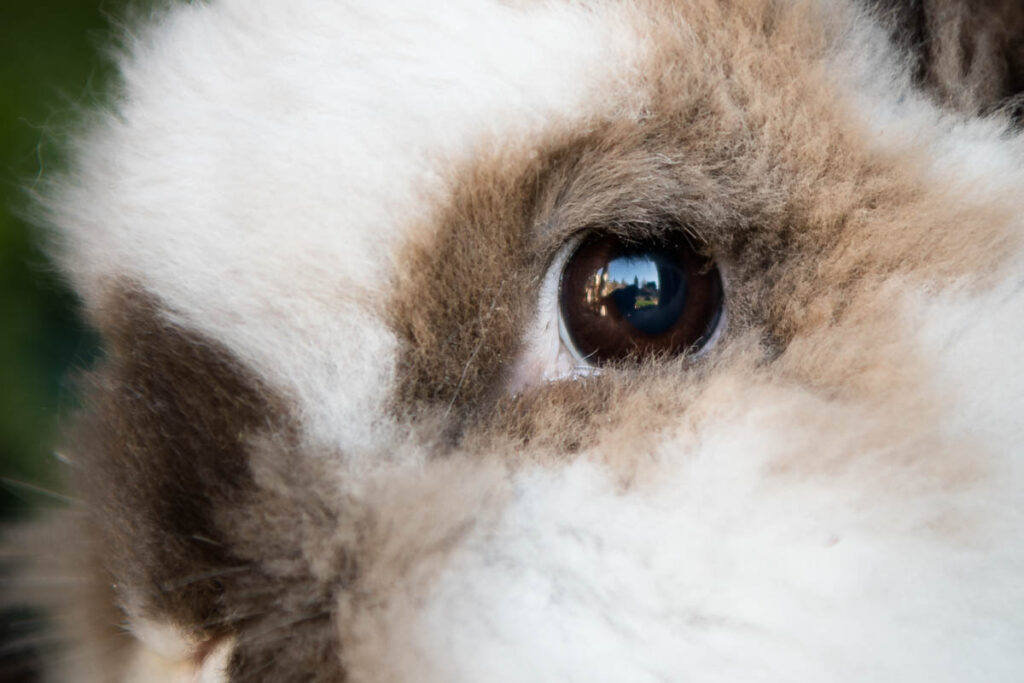This article dives into everything about rabbit eyes, from vision to health challenges and treatments. For rabbits, especially in the wild, vision is key to spotting danger and staying safe.
Physical Design
Rabbits have three eyelids, four tear glands, and only one tear duct opening. Thanks to these unique characteristics, rabbits don’t need to blink very often and this has no effect on the health of their eyes. A Rabbit will blink as little as 12 times an hour – that’s only once every 5 minutes.1
Thanks to their third eyelid, not only do rabbits blink infrequently, bunnies can also sleep without fully closing their eyes, essentially sleeping with them open.2
Why would a bunny sleep with their eyes open? Rabbits sleep with their eyes open as a survival tactic. Remember – they are prey animals. In the wild, this allows their light receptors to remain active. If a predator nears, their brain receives signals faster, enabling a quicker response than if their eyes were closed.
Vision
A Rabbit has a field of vision of almost 360-degrees3 and it can see well above its head and well behind them, too. They have a small blind spot directly in front of them and directly behind them. The eyes are designed for long-sighted use and have limited near vision, aka they are nearsighted. This 360 field of vision also means rabbits don’t have great depth perception.
Fortunately, rabbits have evolved in creative ways to overcome this limitation, enhancing their ability to spot predators and make a quick escape. Rabbits employ a method known as “parallaxing”, moving their heads back and forth to gauge the distance and size of distant objects. This behavior is less common in familiar environments (such as thier home), as rabbits memorize their surroundings. However, introducing a rabbit to a new home or a new furniture layout often prompts this scanning technique during initial explorations.
A rabbit’s pupils have a limited contraction capacity, so they see well in dim/dull conditions. The eye does not have a tapetum, the structure that acts to amplify light that has entered the eye.4
Can rabbits see color?5
According to Anaëlle Laurent at AnimalWised,
Yes, rabbits can see colors but they don’t see the same colors as humans. Rabbits have dichromatic color vision, meaning that they have two types of functioning color receptors, called cone cells, in their eyes. While humans can observe a combination of red, blue and green, rabbits can only observe two colors: blue and green. Meaning that, rabbits are somewhat color blind by human standards.
Rabbit Vision vs. Human Vision by Anaëlle Laurent.
- Cones: detect color under well-lit conditions (photopic vision). Rabbits have about 18,000 per sq. mm at peak density. About 10x less than humans. In other words, rabbits are slightly colorblind by human standards.
- Rods: detect less detail & no color, but they are much more sensitive to light (scotopic vision). Rabbits have about 300,000 per sq. mm. at peak density. About 2x the amount of humans. This means that rabbits can see much better in the dark.
For a full discussion of the rabbit vision system, see our article, “What Do Rabbits See?” by Dana Kremples.
Eye Health Issues
All of the problems described below warrant a trip to a rabbit-savvy vet.
Runny/Weeping Eyes
Runny and weeping eyes are among the most common eye issues. Various things can cause them, including:
- allergies,
- irritants (even eye lashes)
- overgrown teeth
- a blocked tear duct.
See our articles on runny eyes and nose and chronic weepy eyes for a full rundown of signs, symptoms, and remedies. Untreated weepy eyes may irritate and inflame the skin around your bunny’s eyes. It’s best to consult your vet to ensure it’s not indicative of a more serious issue.
Cancer
If your bunny’s eyes show any changes, like iris splotches or pigmented spots in the white area, it’s time for a vet check-up.
Conjunctivitis
Conjunctivitis, often triggered by allergies or irritants, turns the conjunctiva red and painful, sometimes with clear or white discharge. Remove all irritants and head to the vet for antibiotic or anti-inflammatory eye drops.
Corneal Ulceration
Corneal damage in rabbits can result from impacts or scratches, often by rough bedding like straw, leading to ulcers that appear as cloudy pits. Noticeable discomfort and half-closed eyes are signs your rabbit needs vet care for proper treatment.
Cataracts
With age, rabbits may begin to show signs of cataracts in one or both eyes. Cataracts turn the eye’s lens white and cloudy, blocking the light and eventually leading to painless blindness.
Rabbits adapt well in known spaces, and treatment is uncommon. Surgeries exist to restore vision in rabbits with cataracts, but few veterinarians opt to perform them due to the risks and high costs involved. Often aging-related, they can also result from major eye trauma.6
Fortunately, rabbits can lead joyful lives even if they become completely blind. You just want to be sure not to move furniture about and avoid leaving objects on the floor they could unexpectedly bump into.
Glaucoma
Glaucoma, marked by improper fluid drainage and increased eye pressure, makes the eye appear swollen and painful. It’s rare in rabbits but requires vet care, typically with eye drops.
Retrobulbar Abscess
When an abscess forms in the eye socket, it pushes the eye out, causing a bulging look. Often due to tear duct or tooth root infections or a foreign object, it demands vet attention. Treatment might involve antibiotics or, in severe cases, eye removal.
Myxomatosis
Early symptoms of Myxomatosis include sore, swollen eyes and genitals. If you spot these in your rabbit, get vet help ASAP! Vaccination and fly control are key preventatives.
Sleepies (aka Eye Crusties)
Humans get them after sleeping, and bunnies can, too. Usually your bunny can keep himself clean from that little bit of crust around their eyes, especially if they have a bunny friend who likes to groom them. Sometimes, they might struggle to clear it, especially long-haired rabbits. You can gentry clean away this gunk with a warm damp washcloth, or if it’s minor, just a rood rub of the corner of your bunny’s eye. Cleaning these small crusty bits helps to prevent buildup, which can lead to tear duct blockages.
If the discharge is wet and frequent, that’s considered runny or weepy eye and should be checked out by a rabbit-savvy vet.
Checking your rabbit’s eyes
Notice tear production changes; overflow can signal eye issues. Look for color shifts in the eye white, redness, iris spots, irregular pupil edges, or cornea clouding. If your bunny’s eyes change or seem painful, a vet visit is crucial to address these signs or diagnose other problems.
Further Reading
- House Rabbit Network: Windows to the Bunny Soul: Your Rabbit’s Eye Health
- VGR1: Rabbit Vision
- WabbitWiki: Rabbit Eyes
- PDSA (UK): Eye Problems in Rabbits
References
- Hepper Blog: Do Rabbits Blink? ↩︎
- IBID ↩︎
- MCGill Office of Science. Rabbits ↩︎
- World Small Animal Veterinary Association World Congress Proceedings, 2009
Alejandro Bayón del Río, DVM, PhD: Exotic Ophamology II ↩︎ - AnimalWised: Rabit Vision vs Human Vision ↩︎
- PetMD: Cloudy Eye In Rabbits. ↩︎

